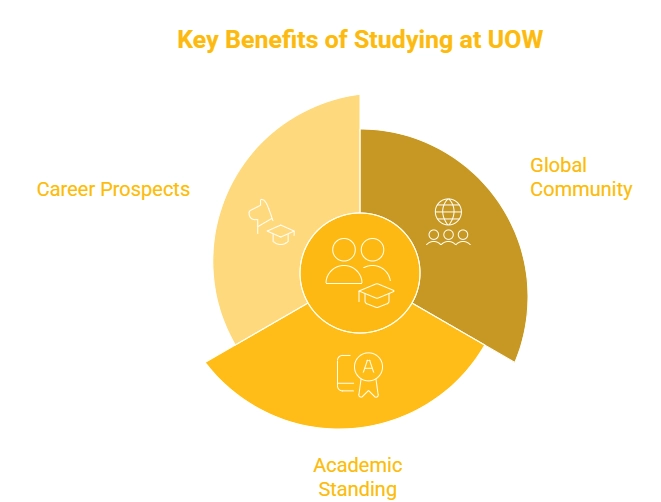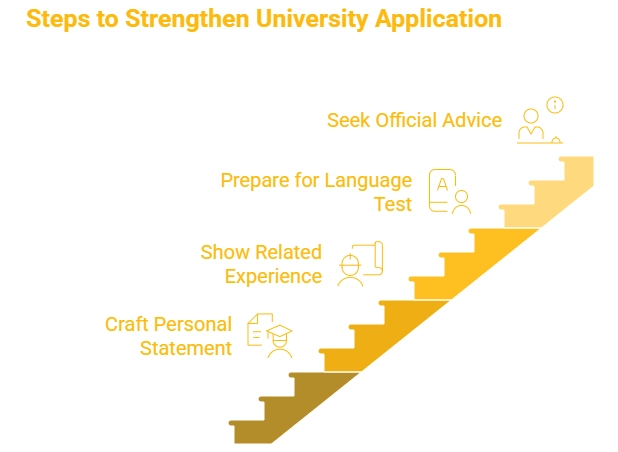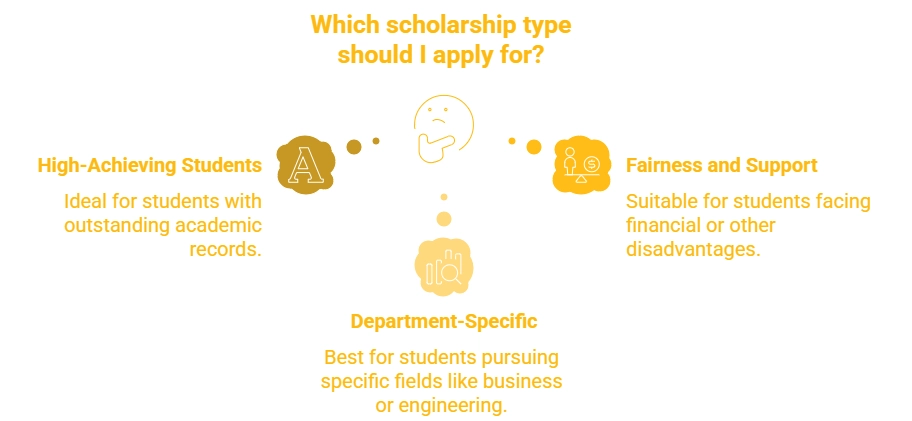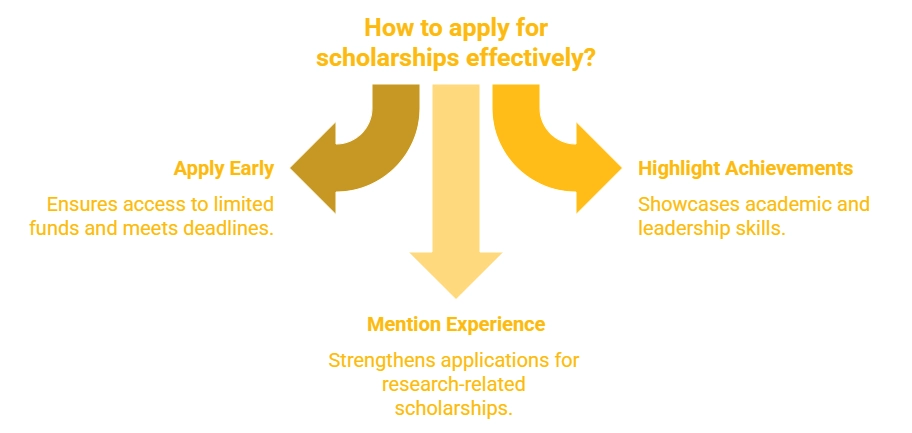Study in Australia
Don't know what to do?
Get Free Counseling
Why apply for University of Wollongong
When picking a university, consider the big picture. Here's what the data says about UOW:
- UOW has 33,044 enrolled students, with 7,231 studying from abroad, making for a diverse and globally involved community.
- The university has over 176,000 alumni across 199 countries, providing a ready-made worldwide network.
- UOW is in the top 1% of universities globally, ranking 167th worldwide and 12th in Australia in the QS World University Rankings 2025.
- The 2022 Graduate Outcomes Survey shows that full-time employment for UOW grads rose from 65.5% to 80.2%, which is better than the national average of 79%.
- The average starting salary for grads also went up from AUD 63,400 to AUD 67,800, one of the largest gains among Australian universities.
Why these matter for UK Applicants?
- Global Community: A large, international student body and alumni network from almost 200 countries means you'll stay connected and have global opportunities.
- Academic Standing: UOW's QS ranking reflects its academic quality and global standing.
- Career Prospects: Good graduate employment rates and salary increases show that a UOW degree is valuable in the job market.
*Need assistance to study in Australia? Y-Axis is here to assist you in all the ways.

University of Wollongong World QS Ranking
UOW is well-regarded in global university rankings, often appearing in the top 200 in QS lists. The latest QS World University Ranking puts UOW in the top 200 worldwide, which shows its strengths in research, sustainability, and international reach. These things are important if you want a degree that employers and other universities around the world will value.
Why Rankings Are Important (But Shouldn't Be the Only Factor)
- Rankings can give you an idea of how much research a university does, its academic reputation, and its international links. But they don't tell you everything. When picking a program, think about subject rankings, campus life, location, and what you'll actually learn in the courses.
How to Use QS and Other Rankings When Choosing a Course?
- If you're applying to a specific field like engineering, business, or health sciences, checks the QS subject rankings. To get a better sense of whether a course is worth the money, combine ranking info with data on graduate employment rates, local industry ties, and research opportunities.
University of Wollongong Acceptance Rate
The University of Wollongong's (UOW) admission standards are moderately competitive. Admission summaries and educational sites usually state an acceptance rate around the middle range (about two-thirds of applicants get in). The rates change based on faculty, course, and applicant background (international or domestic). Selective engineering programs, specific health and psychology degrees, or honors courses have stricter entry needs and lower acceptance rates.
What UK applicants should know about getting in?
- Entry depends on academic transcripts, English language skills (if needed), and any specific course requirements. Some graduate courses want work experience or a portfolio. Always see the course page for the lowest academic standards plus any interview or portfolio needs.
How to make your application stronger:
- Turn in a personal statement that is clear, well-written, and customized for the course.
- Show proof of related experience (internships, projects, research).
- If English is not your first language, prepare for and show a good IELTS/TOEFL/PTE score if it's needed.
- For advice on competitive programs, get official UOW help or use a known education agent.

University of Wollongong Fees
At UOW, tuition depends on the course, study level (undergraduate or postgraduate), and the number of credit points taken each session. The university provides fee guides and session fee details. Many bachelor's degrees include total and per-session cost estimates in the official fee schedule. For example, the 2024/2025 fee tables show estimated total and per-session fees for different faculties like business, arts, engineering, and health. International students should check the official course finder and international fees pages for the latest credit and session costs.
|
Metric |
Official Figure |
|
Total students enrolled |
33,044 (including 7,231 offshore learners) |
|
Alumni network |
176,000+ graduates in 199 countries |
|
QS World University Ranking 2025 |
167th globally, 12th in Australia |
|
Graduate full-time employment rate |
80.2 % (up from 65.5 %) |
|
National average graduate employment rate |
79% |
|
Median graduate salary (full-time) |
AUD 67,800 (up from AUD 63,400) |
To find the specific fees for your course:
- Refer to the UOW Course Finder and the International Student Fees pages. These resources offer the most exact and up-to-date figures for each course. Keep in mind that fees are subject to change each year and will vary depending on your study load. Always confirm the current fee on the university website before accepting an offer.
Courses offered at University of Wollongong
UOW has many programs across its departments, giving UK students many options for what to study:
- Arts, Social Sciences & Humanities Department: classes in communications, humanities, social sciences, and creative fields.
- Business and Law Department: undergraduate and graduate classes in business, commerce, law, and management.
- Engineering and Information Sciences Department: engineering fields, computer science, and tech degrees with industry ties.
- Science, Medicine & Health Department: science degrees and growing health/medical programs, with research and clinical work options in some.
- Things that may help you choose:
- Interdisciplinary options: Many degrees let you combine majors or study minors from different departments.
- Industry work: UOW focuses on placements and industry projects, mostly in engineering and business subjects.
- Global campuses and exchange: students can study abroad or do some coursework at UOW's international locations, useful for those wanting global experience.
- How to look at classes:
- Use UOW’s Course Finder to sort by level (undergrad/postgrad), campus, and subject. Read course descriptions, learning goals, and job options to choose what fits you.
University of Wollongong scholarships
The University of Wollongong (UOW) offers many scholarships for both local and international students, including those based on academic success, fairness, alumni status, and specific departments. Some scholarships are considered automatically when you apply, but others need a separate application. Common types include:
- Scholarships for high-achieving students.
- Fairness and support scholarships for students with financial or other disadvantages.
- Scholarships for specific departments or courses (like business, engineering, or creative arts), which may be aimed at international students.

How UK Applicants Can Get Scholarships
- Visit the UOW international scholarships page to see what's available, when the deadlines are, and what the requirements are. Some scholarships are automatically given during admissions, while others need extra documents or essays. Be sure to check deadlines early and get your transcripts, references, and any required statements ready.
Tips for Applying
- Apply early because many scholarships have limited funds or deadlines.
- In your personal statements, focus on your academic achievements, leadership skills, and any relevant extracurricular activities.
- If you have research or work experience, mention it when applying for scholarships related to research.

University of Waterloo Accommodation Options for International Students
UOW gives many housing choices that fit different budgets and ways of living. These include places to live on campus, student housing connected to the school, and tips for renting privately. Living on campus is easy and creates a sense of community. Living off campus gives you more freedom and can sometimes be cheaper, depending on where you are. UOW's housing services and StudyStays website let students search for and compare options in Wollongong and nearby areas.
On-campus benefits
- Living spaces often have meal plans, group activities, and support, which can really aid first-year international students getting used to life in Australia.
Tips for UK students living off campus:
- If you intend to rent privately, think about how close you are to school, public transportation (to Wollongong and other cities nearby), how much utilities cost, and lease agreements. UOW offers advice and listings to aid you stay away from scams and pick a spot that works with your budget.
Budgeting for a place to live:
- Prices change based on the type of housing. Shared apartments or homestays tend to be less costly than halls where meals are served. Remember to include the bond (security deposit), utilities, and transport expenses when figuring out total living costs.
University of Wollongong application process
To apply to the University of Wollongong:
Step 1: Pick a course using the UOW Course Finder. Review the course details for entry needs, prerequisites, and English skills standards.
Step 2: Get your documents ready. Usually, you will need transcripts, certificates, English test results (IELTS, TOEFL, and PTE if needed), a CV (for postgraduate courses), a passport copy, and a portfolio (for design courses).
Step 3: Apply online or through a UOW agent. Agents can help you with entry needs and student visas.
Step 4: If your application is accepted, you will get an offer letter. Sign the acceptance form and pay the deposit to accept.
Step 5: After accepting, UOW will send your Confirmation of Enrolment (CoE), which you need for your visa application.
Step 6: Apply for the Australian Student Visa (subclass 500). Also, get Overseas Student Health Cover (OSHC).
Step 7: Arrange your accommodation and travel
Step 8: Attend orientation to meet other students, set your timetable, and learn about campus services.
Why Choose Y-Axis?
- Professional Advice for UK Applicants: Tailored assistance for UK students submitting applications to universities in Europe.
- End-to-End Application Support: Everything under one roof, from choosing a university to applying for a visa.
- Scholarship Help: We assist you in locating and submitting applications for the top scholarships for which you qualify.
- Preparation and Review of Documents: Proper documentation is necessary to prevent application delays or rejections.
- Trusted by Thousands: More than 1 million customers have used Y-Axis to successfully complete their international education.
Testimonials
Frequently Asked Questions
